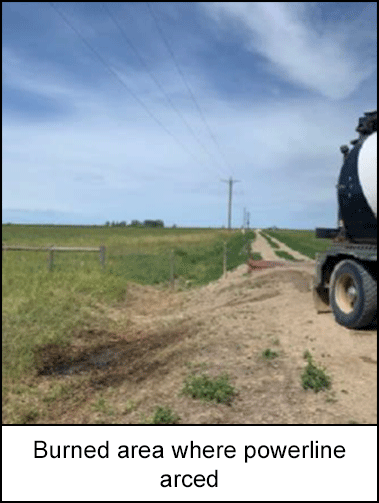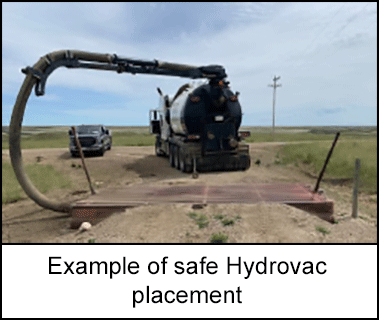-
What happened?
A worker was hydro vacuuming a cattle gate near high voltage overhead powerlines. The worker received a shock when the equipment being used made contact with the overhead powerline.
The worker was thrown onto the ground when energy was transferred from the powerline through the equipment. The worker received minor injuries; however, this event could have resulted in more severe injuries or a fatality.

-
Why did it happen?
The equipment used made contact with the high voltage overhead powerline. The transfer of energy from the powerline resulted in minor injuries to the worker.
The primary causes include a failure to include overhead hazards in the field-level hazard assessment, inadequate equipment positioning violating provincial standards (seven-meter safe approach limit), and a lack of visual supervision to ensure sufficient space during work near powerlines.

-
What did they learn?
- Field level hazard assessment must include overhead hazards.
- Equipment positioning must maintain a safe approach limit as per the provincial standards, in this case - seven meters, for the powerline.
- Visual supervision, to ensure adequate space while conducting work in proximity to overhead.
Recommendations:
- Review all hazards, associated risks and mitigating controls during work planning and permitting with a focus on hazardous energy that can lead to a potentially serious incident.
- Review the expectations for supervision based on the hazards and risks present.
- Ensure the workplan addresses equipment placement dependent upon site hazards.
- Evaluate hazards when arriving at the worksite by conducting a field level hazard assessment.
- Consult the appropriate provincial OHS regulations for minimum powerline distancing before working near overhead powerlines.

-
Ask yourself or your crew
How can something like this happen here (e.g. on our site)?
What safety measures (i.e. procedures, controls/barriers) do we have in place to mitigate the risk?
How do we know the risk controls/barriers are working?
What improvements or changes should we make to the procedures, controls/barriers or the way we work?

Add to homescreen
Content name
Select existing category:
Content name
New collection
Edit collection
What happened?
A worker was hydro vacuuming a cattle gate near high voltage overhead powerlines. The worker received a shock when the equipment being used made contact with the overhead powerline.
The worker was thrown onto the ground when energy was transferred from the powerline through the equipment. The worker received minor injuries; however, this event could have resulted in more severe injuries or a fatality.

Why did it happen?
The equipment used made contact with the high voltage overhead powerline. The transfer of energy from the powerline resulted in minor injuries to the worker.
The primary causes include a failure to include overhead hazards in the field-level hazard assessment, inadequate equipment positioning violating provincial standards (seven-meter safe approach limit), and a lack of visual supervision to ensure sufficient space during work near powerlines.
What did they learn?
- Field level hazard assessment must include overhead hazards.
- Equipment positioning must maintain a safe approach limit as per the provincial standards, in this case - seven meters, for the powerline.
- Visual supervision, to ensure adequate space while conducting work in proximity to overhead.
Recommendations:
- Review all hazards, associated risks and mitigating controls during work planning and permitting with a focus on hazardous energy that can lead to a potentially serious incident.
- Review the expectations for supervision based on the hazards and risks present.
- Ensure the workplan addresses equipment placement dependent upon site hazards.
- Evaluate hazards when arriving at the worksite by conducting a field level hazard assessment.
- Consult the appropriate provincial OHS regulations for minimum powerline distancing before working near overhead powerlines.

Ask yourself or your crew
How can something like this happen here (e.g. on our site)?
What safety measures (i.e. procedures, controls/barriers) do we have in place to mitigate the risk?
How do we know the risk controls/barriers are working?
What improvements or changes should we make to the procedures, controls/barriers or the way we work?
A worker was hydro vacuuming a cattle gate near a high voltage overhead powerline. The worker received a shock when the equipment made contact with the overhead powerline. The worker was thrown onto the ground when energy was transferred from the powerline through the equipment. The worker received minor injuries, however potential for serious injury or fatality.
Original material courtesy of Energy Safety Canada













